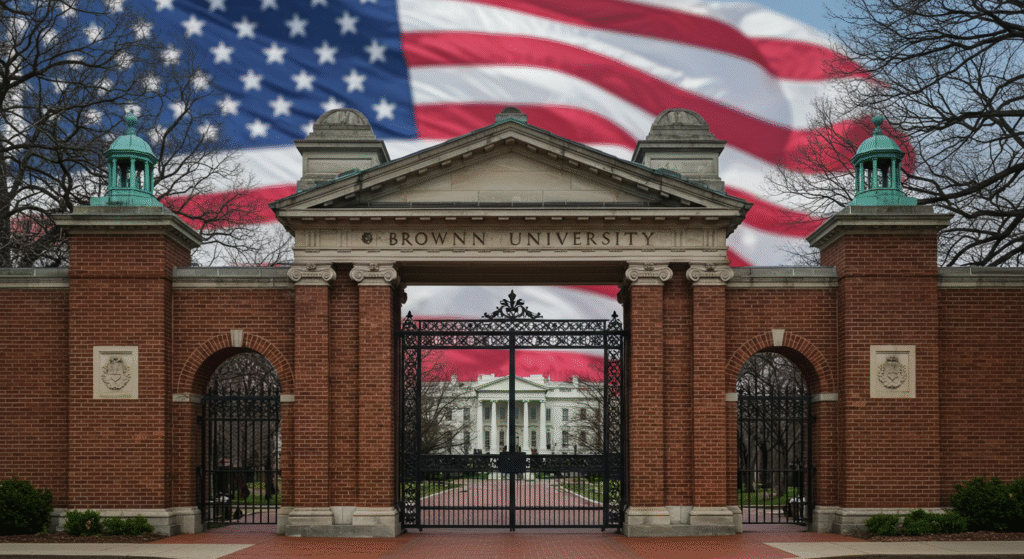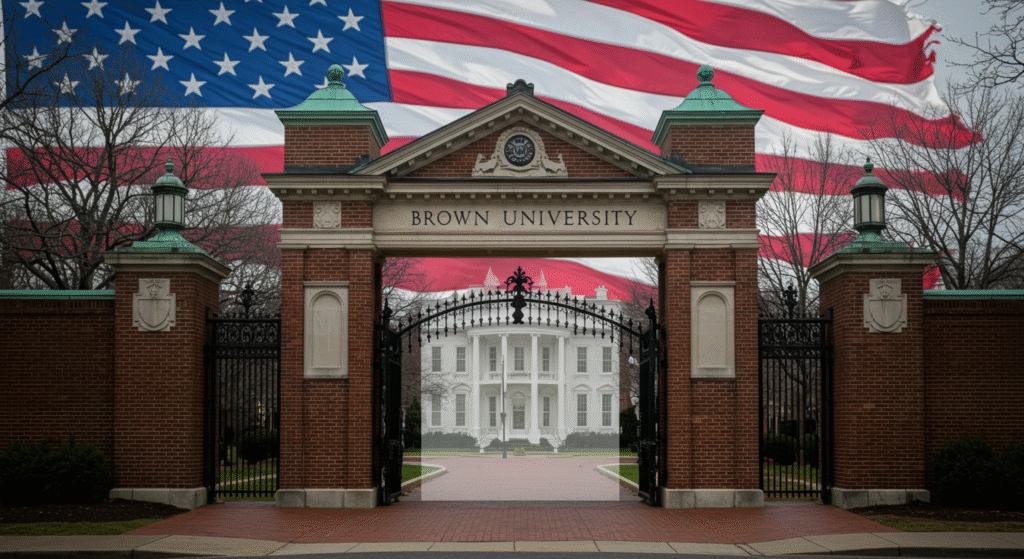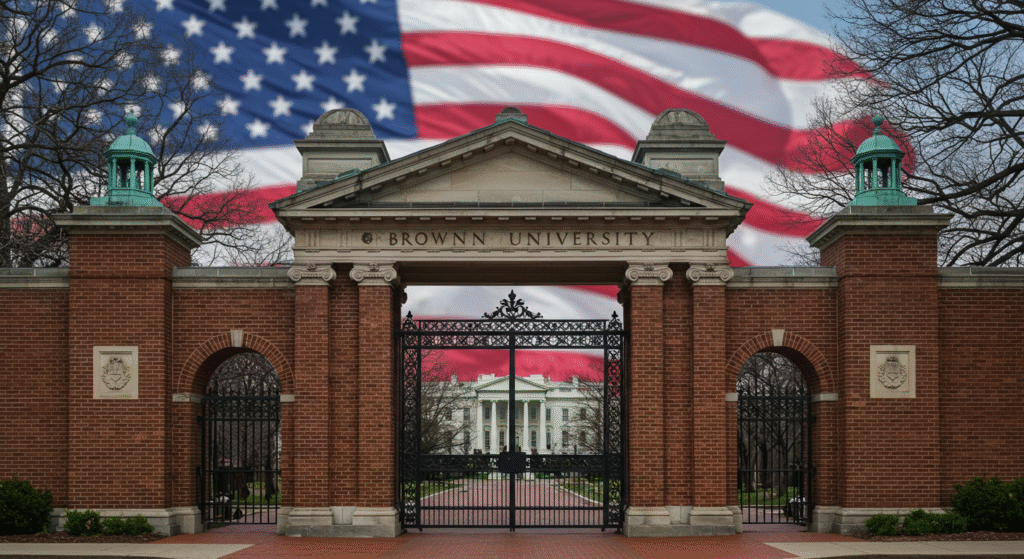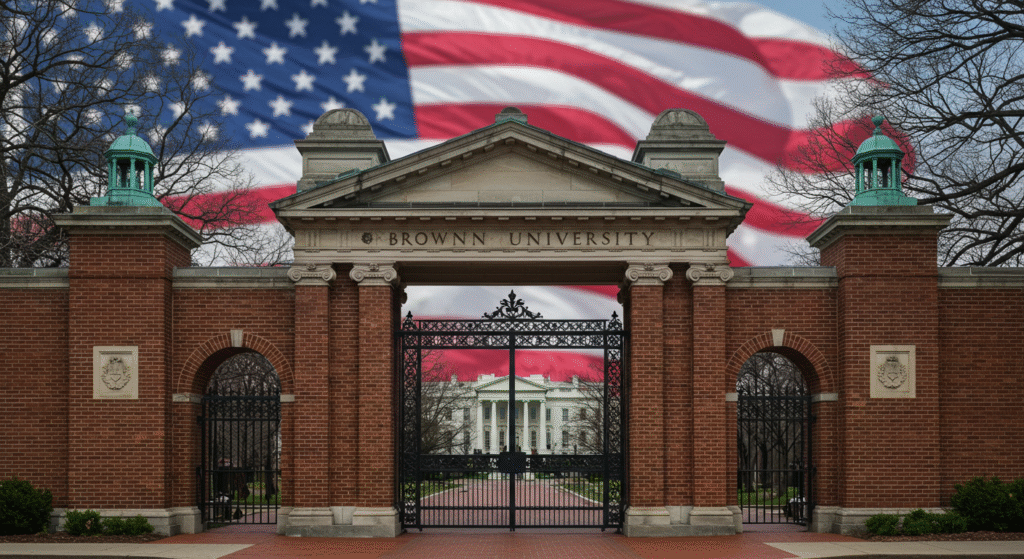Brown University strikes $50M deal with White House to restore $510M in federal funding, balancing academic freedom with new policy commitments.

1. Introduction: A High‑Stakes University Showdown
In late July 2025, Brown University found itself at the center of a dramatic confrontation between elite academia and the Trump administration. The university, based in Providence, Rhode Island, reached a landmark settlement that would restore frozen federal research grants—at significant cost and under strict conditions. In many respects, Brown’s deal represented the third in a cascade of agreements between Ivy League institutions and the federal government, signaling a broader shift in higher education governance.
2. Background: Why Federal Funding Was in Jeopardy
2.1 Federal Grants Blocked
In April 2025, education policy from the White House threatened to freeze roughly $510 million in federal research grants to Brown, spanning medical and health sciences projects U.S. Department of Education+15Reuters+15The Guardian+15. This action followed earlier moves to pause funding for other universities, including Cornell, Northwestern, Penn, and Harvard, often citing concerns over antisemitism, diversity initiatives, transgender policies, and campus protests ABC News+4Wikipedia+4The Daily Beast+4.
Unlike those universities that chose legal resistance, Brown pursued a negotiated path—an attempt to regain funding without litigating. By mid‑July, Brown had already borrowed $800 million in loans to survive without federal support ABC NewsNew York Post.
2.2 The Broader Pressure Campaign

The Trump administration had escalated a campaign targeting “woke” policies in higher education, including affirmative action, LGBTQ+ rights, and pro‑Palestinian protests. Two universities—University of Pennsylvania and Columbia University—had already reached agreements earlier in July, paying over $200 million in Columbia’s case, with terms including oversight, programmatic reform, and academic limits The Wall Street Journal+3AP News+3ABC News+3.
These deals were rapidly cast as proofs of concept—Blueprints for transforming campus policies across elite institutions The Daily Beast+1washingtonpost.com+1.
3. The Deal Itself: Key Terms and Conditions
3.1 Financing Measures
Brown agreed to pay $50 million over 10 years—specifically allocated to workforce development programs within Rhode Island—rather than paying the federal government directly The Guardian+9Reuters+9usnews.com+9. These investments would support technical training, job readiness, and local workforce initiatives, aligning partly with the administration’s broader economic narrative.
3.2 Policy Concessions
Brown accepted several mandates reflecting administration policy priorities:
- Admissions: The university will no longer consider race in its admissions decisions and will maintain “merit‑based” practices usnews.comwbur.org+2Politico+2wvxu.org+2.
- Gender Policies: Transgender women will be excluded from women’s sports, housing, and facilities. Brown committed to using the administration’s executive‑order definitions of “male” and “female.” Minors will not receive gender-affirming medical care at the university CBS News.
- Climate and Antisemitism: The university will commission a joint external survey to assess campus climate for Jewish students, submit findings to the government, and propose corrective actions. It will strengthen programming around Judaic Studies and Jewish community life Reuters+1wvxu.org+1.
- Transparency: Brown will supply federal agencies with admissions data and information about discrimination complaints for audit purposes. Admissions demographics, test scores, race, and grades will be subject to review wvxu.org.
- DEI Restrictions: The university must end any programs enforcing diversity quotas, race-based outcomes, or DEI targets deemed “unlawful” under federal interpretation CBS News+3wbur.org+3New York Post+3.
3.3 Academic Independence Preserved

A central condition agreed to by both parties: the federal government may not dictate academic curriculum, compel speech, or control the content of academic discourse at Brown wbur.org+2ABC News+2wvxu.org+2. Unlike Columbia, Brown’s deal did not appoint an independent monitor; instead, compliance will be handled directly with federal agencies wbur.org+2The Guardian+2wvxu.org+2.
Brown explicitly denied any violation of law or entitlement to liability under the agreement ABC News+1CBS News+1.
4. Official Responses: University and Federal Leaders
4.1 Brown’s Position
Brown President Christina Paxson published an open letter declaring that the agreement:
- “Preserves the integrity of Brown’s academic foundation”
- Enables the campus community to move forward after months of uncertainty
- Reflects obligations already enshrined in federal antidiscrimination law—asserting that many of the required policies aligned with Brown’s existing practices The Guardian+6ABC News+6Politico+6CBS News
She carefully addressed faculty and student concerns, noting that negotiation was preferable to litigation due to the immediate financial harm inflicted by the freeze. Paxson emphasized that the deal balanced legal compliance and academic freedom — acknowledging concerns but refusing to concede liability ABC Newswvxu.org.
4.2 Trump Administration’s Framing
Education Secretary Linda McMahon hailed the deal as a “lasting legacy”:
“Aspiring students will be judged solely on their merits, not their race or sex. The Trump Administration is successfully reversing the decades‑long ‘woke‑capture’ of our nation’s higher education institutions” The Guardian+5U.S. Department of Education+5wbur.org+5.
The administration portrayed Brown’s deal, alongside Columbia’s, as examples for all universities under scrutiny—intended to reshape campus culture around merit, ideological balance, Title IX enforcement, and antisemitism safeguards Politico.
5. Broader Impacts and Context
5.1 Ivy League Deal Precedents
Brown followed Columbia (approx. $200 million settlement) and Penn in structuring its agreement. While Columbia’s included an external monitor and a direct payment to the federal treasury, Brown’s allowed greater autonomy in fund allocation and omitted external oversight AP Newswashingtonpost.comPolitico.
Harvard remains embroiled in negotiations—reportedly facing over $2 billion in threatened funding if it fails to comply, with potential legal challenges already underway ABC News+1The Times of India+1.
5.2 Academic Freedom at Stake
Many faculty and civil‑rights groups condemned the federal pressure as authoritarian, suggesting that tying research funds to ideological concessions undermines the autonomy central to university governance WikipediaThe GuardianAP News.
Ted Mitchell, head of the American Council on Education, called these tactics “simple extortion and deal‑making, which has no place in a democracy” wvxu.orgPolitico.
Some faculty at Brown expressed relief that their agreement was less intrusive than Columbia’s. As one professor observed:
“This feels like mostly things that Brown had to do anyway… Brown has navigated this process in a way that maintains its core mission” wvxu.org.

5.3 The Financial Toll
Because Brown lost reimbursements and was unable to compete for new contracts, officials say the freeze cost at least $50 million in unreimbursed NIH expenses—and counting at roughly $3 million per week CBS News. That prompted loans of $800 million just to maintain operations prior to the settlement ABC NewsNew York Post.
6. Why It Matters: Implications for Higher Education
6.1 Long-Term Institute Models
Brown’s model—of routing funds into workforce development and preserving academic autonomy without a third‑party monitor—may serve as a blueprint for other institutions facing similar demands. It showed a way to settle while maintaining greater control over institutional mission and fund use The GuardianPolitico.
6.2 The Balancing Act
For Brown, the settlement reflects tension between upholding principles of academic freedom and responding to existential financial threats. The deal preserved many existing university policies—but came at the cost of ideological compromise on admissions and gender policy.
6.3 Ongoing National Debate
Critics argue this marks a moment when federal authority is encroaching on academic institutions—transforming political disagreements into funding conditions. Advocates warn of chilling effects: self‑censorship, curricular shifts, suppression of protest, and narrowing of research agendas The GuardianAP News.
Supporters maintain it’s a necessary reassertion of federal priorities—merit, equity before group identity, campus safety for Jewish students, and enforcement of Title IX as originally intended U.S. Department of EducationReuters.
7. Filling in Detail: Timeline & Timeline Clarifications
- April 2025: Trump administration signals intent to withhold ~$510 million from Brown for alleged antisemitism and race‑based admissions Politico.
- May–June 2025: Other institutions—Penn, Columbia—negotiate settlements and come under lengthy scrutiny.
- Late July 30, 2025: Brown announces voluntary settlement; agreement released publicly (~9 pages); funding freeze lifted, $50 million commitment confirmed CBS News.
8. Voices & Perspectives
8.1 Inside Brown
Some faculty members—especially those who had previously opposed any settlement—chose to sign a petition urging resistance. Others expressed cautious optimism that the university preserved its values while avoiding an external monitor.
President Paxson’s internal message emphasized that Brown never received finding of legal violation, and framed negotiation as a strategic choice—not capitulation.
8.2 External Reaction
Education advocates and higher ed groups criticized the process as undermining academic independence. Some lawmakers and civil rights organizations continue to challenge the administration’s broader policy, even as courts have nullified the wide federal pause on DEI funding earlier in 2025 ABC News.
Meanwhile, within conservative circles, the deal was praised as a turning point in restoring “American values” in academia—merit-based admission, rejection of DEI, protection of women’s-only spaces and Jewish communities U.S. Department of Educationaxios.com.
9. The Road Ahead
Harvard remains entrenched in legal and political standoff: facing potential $2 billion in penalties and continued litigation. The outcome could determine how powerful the administration’s playbook will be in the coming decade WikipediaThe Times of India.
Other universities—Cornell, Northwestern, Duke, Princeton and beyond—are being pressured similarly. The Brown and Columbia precedents may shape the contours of future negotiations.
10. Conclusion: A Defining Moment
Brown University’s July 2025 settlement signifies more than just the return of research funds. It represents a flashpoint in the defining battle over the soul of American higher education: institutional autonomy versus federal ideological priorities.
By choosing negotiation over litigation, Brown struck a compromise—preserving funding and life-saving research in exchange for regulatory change. But critics warn it may also have ceded ground in a broader struggle over free speech, inclusion, protest, and the nature of academic governance.
As higher education enters the post‑Columbia and post‑Brown era, the university landscape is being reshaped by decisions not just of faculty senates or boards of trustees—but by the political will and funding leverage of the federal
MUST SEE
THIS .